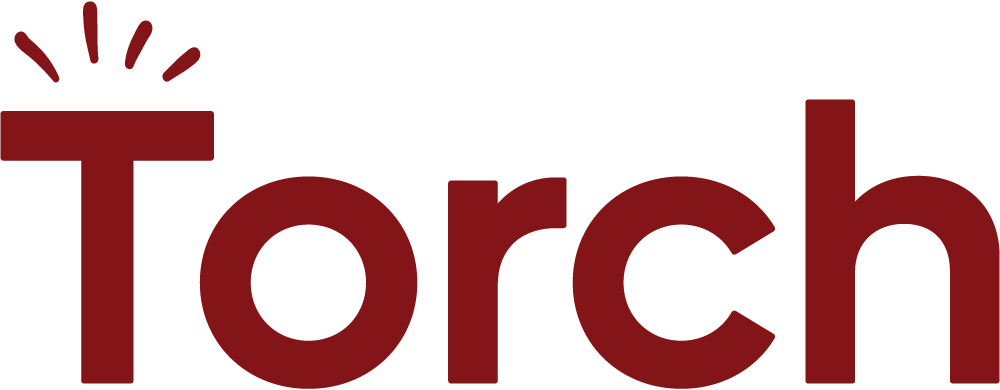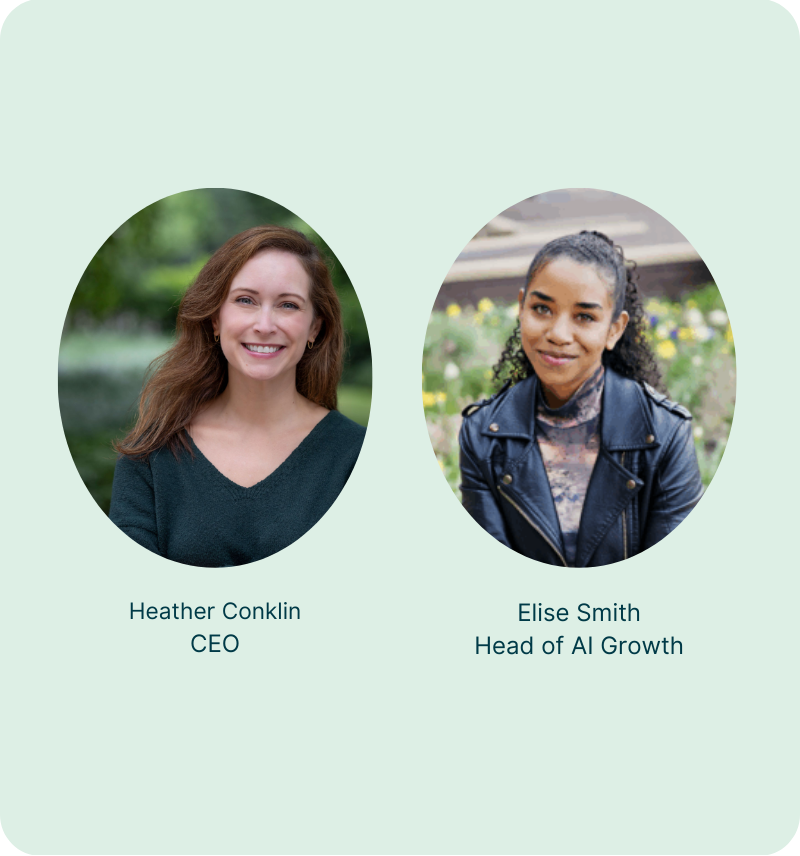We recently partnered with Achieve Engagement for a webinar where Heather Conklin (Torch CEO) and Elise Smith (Head of AI Growth) shared what’s really going on inside companies navigating AI. Too often, tech gets all the investment while the people side of transformation gets overlooked.
Watch the recording or keep reading for the insights that landed hardest most with the audience.
AI changes how people think, not just what tools they use
Past technology implementations meant learning new interfaces. AI works differently. Elise reframed the entire challenge with this observation:
“It’s the first technology that actually partners with human cognition. Previous technology changes, whether it’s email, computers, smartphones, these were tools that enhanced our existing work. They made our processes faster. They made us more efficient. But you didn’t really have to change how you thought.” — Elise Smith, Head of AI Growth
When ChatGPT launched, her team at Praxis Labs (before being acquired by Torch) threw out their entire playbook. Her then co-founder and CTO led the charge:
“They pushed us to not think of our old ways of working and our old ways of developing products as precious. They encouraged us to envision what could be and work backwards from there instead of trying to do, like, incremental changes that would get us to a new place.” By the second half of 2023, they’d rebuilt everything from team structure, to product suite, to development cycles.
Most companies are still running lunch-and-learns, thinking that’ll prepare people for cognitive disruption. Meanwhile, their leaders are struggling in silence with fears they can’t voice.
Your leaders are panicking and won’t tell you
Heather exposed the gap between what executives say publicly and what they’re actually feeling:
“There’s this hidden reality to all of this that doesn’t get said out loud very often, which is, I don’t actually know what I’m doing. Or if I’m doing this right. I’m afraid I’m going to look stupid if I ask basic questions. These companies are saying you have to be AI-first, otherwise, you don’t have a job. It doesn’t leave space to say you’re struggling.” — Heather Conklin, CEO
Google just announced another round of “get on board or get out” messaging (Heather mentioned seeing this article that morning). Companies everywhere are taking this command-and-control approach, thinking fear will drive adoption. Instead, that pushes confusion underground where it undermines everything.
When we polled attendees about their biggest AI transformation concern, most pointed to “lack of clear strategy and direction.” But underneath that is a deeper challenge. If leaders don’t know what questions to ask, it’s nearly impossible to build strategy that works.
LinkedIn scaled AI readiness coaching company-wide
While most companies run hackathons and hope for the best, LinkedIn recognized that AI readiness requires a fundamentally different approach. They made a bold commitment by scaling coaching to everyone at the director level and below across the entire company. Not to teach AI tools, but to build the adaptive leadership capacities their workforce needs to thrive as AI reshapes how they work.
“It’s been such an amazing journey. We’ve worked with thousands of people over the last year, bringing a more precise way of coaching into LinkedIn. We’re developing them toward a goal and toward an outcome that the company really needs from them.” — Heather Conklin, CEO
We’ve coached thousands of LinkedIn employees on navigating AI transformation in their specific contexts. A product manager gets different support than someone in sales because AI disruption hits every role differently. The strategic advantage comes from the continuous learning loop we create by gathering insights about what’s actually blocking AI adoption and feeding that intelligence back to LinkedIn’s leadership.
What surprised both speakers was how much joy and human connection drive successful transformation. Creating safe spaces for vulnerability and learning accelerates adoption faster than mandate-driven approaches. This is what strategic AI readiness looks like.
The three paths companies are taking
When it comes to AI readiness, Heather sees organizations falling into three approaches:
- Command and control. “Get on board with AI or you don’t have a job here.” Fear-based compliance that pushes confusion underground.
- Random experimentation. Lunch-and-learns, hackathons, innovation time. Better than nothing, but creates a knowledge-to-application gap that leaves people thinking, “How do I actually apply this to my specific work?”
- Strategic development. Companies that acknowledge this is fundamentally about changing how people think, not just what tools they use.
The successful companies don’t bolt AI onto existing processes. They imagine what work could look like if they started fresh, then work backwards. Elise experienced this at Praxis:
“What I’m most proud of is doing all of this change by leading with our values and making sure that we were putting our team and our human centered approach first as we were navigating all of this change.” — Elise Smith, Head of AI Growth
The stakes are higher than you think
While companies debate which AI tools to buy, they’re missing the real cost of inaction. Heather didn’t sugarcoat the bigger issue:
“How much time and competitive advantage are you gonna be willing to leave on the table while people just kind of naturally figure this out? You can actually take this much more strategic and systematic approach to building the kind of capacity that would get you breakthrough results in months instead of years.” — Heather Conklin, CEO
Meanwhile, 95% of generative AI pilots are failing while companies pour millions into technology and almost nothing into preparing their people.
What we learned: Tactics from the webinar
- Start with fear mapping. Ask each function specifically what they’re afraid AI will do to their role. Surface the real resistance hiding behind “lack of strategy.”
- Use LinkedIn’s continuous learning model. Create feedback loops that turn individual coaching into organizational intelligence. What patterns emerge across hundreds of conversations?
- Apply the three-path framework. Are you stuck in command-and-control fear, random experimentation, or building strategic development capacity? Be honest about where you are.
- Go first with your HR team. Transform your own work with AI before rolling anything out company-wide. Build credibility through lived experience.
Your questions, answered
For companies at the leading edge of AI adoption, what role are their HR leaders playing in shaping strategy?
Heather emphasized that leading HR leaders experiment on their own teams first: “They are actually taking their teams and saying, alright, how do we be a best in class example of this on our team? And we go through this change ourselves so that we can talk about it with other people from a place of real lived experience and credibility.”
Five years from now, what will separate organizations that thrive in AI transformation from those that struggle?
Both speakers agreed it comes down to building adaptive capacity. Heather’s response: “Companies acknowledging that we have to change how we drive change. Those are the ones that are going to really see something different here. The companies that really invest in building that capacity in their organization will just be set up for success.”
How should organizations assess AI readiness across their workforce?
Bob’s suggestion from the chat captured what both speakers emphasized: individual assessment at scale. Heather noted that “AI impacts every industry really differently. It impacts every company really differently, every function, every level…nothing one size fits all is really gonna work here.” The key is gathering individual-level data that enables targeted development rather than blanket training programs.
Build AI readiness that goes deeper than tools
Our AI Readiness Coaching takes a different approach. Instead of coaching leaders in isolation, we coach them in the context of your company’s real priorities.
Our exceptional coaches, who have led teams themselves, connect business needs with each leader’s challenges and strengths, creating growth that drives results at every level. Over time, these connections form a continuous loop of learning and adaptation, turning AI readiness into a lasting advantage.
AI is new territory for everyone. No one has it figured out yet. But organizations that focus on the human side of this transformation, equipping their people to lead through uncertainty, will be the ones to move ahead. Ready to lead differently? Let’s talk.
Speaker spotlights
Build confident leaders for the AI era
Torch AI Readiness Coaching helps leaders translate AI ambition into action, creating the clarity and confidence needed to drive real change.



